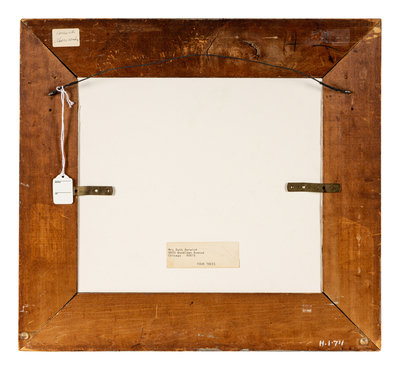Lot 124
We are grateful for the research conducted by Susan Weininger, Professor Emerita, Roosevelt University.
Provenance:
Mrs. Ruth Horwich, Chicago, until 2014
Exhibited:
Chicago, Illinois, University of Chicago, Renaissance Society, Hyde Park Collects: Hyde Park-Kenwood Centennial Exhibition, May 28 - June 15, 1962 (as Owls in Trees)
Chicago, Illinois, Hyde Park Art Center, Gertrude Abercrombie, A Retrospective Exhibition, January 28 - March 5, 1977, no. 59 (as Four Trees and erroneously catalogued as unsigned and undated)
Lot Essay:
Four Trees and Three Owls, 1950, depicts a bleak, moonlit landscape with four trees, owls in or on three of them. The artist frequently painted leafless trees and owls, as well as the moon, all of which had personal meaning. Her use of the same elements but in unique configurations contributed to the differing significance of each artwork. There are a number of compositions in which owls are situated in or on leafless trees, often with Abercrombie overseeing the scene as a director or teacher. These include, among others, Owl Trainer (School for Owls), 1945 (Private Collection), and Owl Trainer #2, 1947 (Private Collection). In the former, two small pink owls sit on the branches of the tree while a third peeks out from an opening in the trunk. Owls sometimes peer out of other enclosures, such as cracks in shells, as in Shell and Owl, 1970 (Private Collection).
Like many of the artist’s artworks from the late 1940s and into the 1950s, this example is meticulously executed. During this time, Abercrombie’s good friend, the artist John Wilde, encouraged her to paint more carefully and with more detail. Many of her paintings from this period bear out her diligence of this advice, including Four Trees and Three Owls, which is beautifully rendered and precisely composed to produce a unified whole. Abercrombie was also enormously productive during the early 1950s. She was recently divorced and remarried to a husband who was not an ideal provider, and she was concerned with generating income for her family. As part of this effort and because of her increasing popularity, the artist was the subject of five solo exhibitions and participated in twelve group shows between 1950 and 1952.
In Four Trees and Three Owls, the figure of Abercrombie is not present, but her moon (according to her, the moon, long associated with women, was hers) and the owl, linked to wisdom as well as darkness, stand in her absence. The juxtaposition of dark, represented by the three trees to the left, and light, symbolized by the pure white tree on the right, set under the bright moon, make this point. As in other works by the artist, the ambiguity or tension between these contrasting ideas exists in a seamless whole. Likewise, the captivating owls that can be glimpsed in the trees express not only mystery and enchantment, but Abercrombie’s characteristic wittiness. This charming, magical, and exquisitely rendered image represents the pure wisdom as well as the powerful magic that the artist attributed to herself and is full of both humor and gravity.
The present artwork was originally owned by Ruth Horwich, a Hyde Park resident. She was one of the founders of Chicago’s Museum of Contemporary Art, served on the 20th Century Painting and Sculpture Committee at the Art Institute of Chicago, and was chaired on the Hyde Park Art Center’s board for forty years. She and her husband Leonard had a large and significant collection of contemporary art, including many examples by Chicago artists. The inclusion of Abercrombie’s painting in a premier art collection of the time speaks to its importance, as well as to the artist herself.















